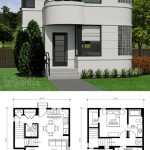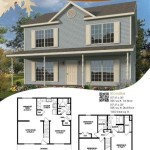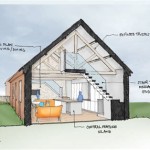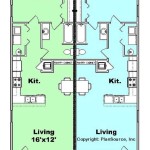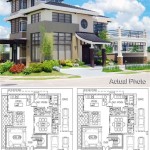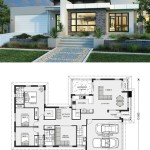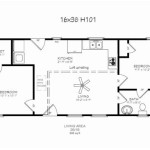How To Get Building Plans For A New House
Embarking on the construction of a new house necessitates meticulous planning, and at the core of this planning lies the acquisition of comprehensive and accurate building plans. These plans serve as the blueprint for the entire project, guiding every aspect from the foundation to the roof, and ensuring compliance with local building codes. The process of obtaining these plans can seem daunting, but by understanding the various options and associated steps, aspiring homeowners can navigate this critical phase with confidence.
The building plans are far more than just drawings; they are a legally binding document that outlines the precise specifications of the house. They detail the layout, materials, dimensions, and structural integrity of the building. They are crucial for obtaining building permits, securing financing, and effectively communicating the design to contractors. Without detailed and accurate plans, the construction process can be plagued by errors, delays, and cost overruns. Securing appropriate plans is, therefore, the most important initial step in building a new house.
Understanding the Types of Building Plans
Before embarking on the search for building plans, it's essential to understand the different types available. These categories vary based on the level of detail, customization, and intended use. Each type offers a different balance between cost, convenience, and design flexibility.
Stock Plans: Stock plans, also referred to as pre-drawn plans, are readily available and offer a cost-effective solution for homeowners who are seeking a standard design. These plans are typically created by architects or design firms and sold to multiple clients. They offer a variety of styles and sizes, catering to a broad range of preferences. The advantage of stock plans lies in their affordability and immediate availability. However, they offer limited customization, and may require modifications to comply with local building codes or site-specific requirements. Homeowners should be prepared to engage a local architect or engineer to adapt stock plans to their particular needs and location.
Custom-Designed Plans: Custom-designed plans offer the highest degree of personalization, allowing homeowners to create a house that perfectly matches their unique needs, preferences, and lifestyle. These plans are developed by an architect in close collaboration with the homeowner, resulting in a design that is tailored to the specific site conditions, desired aesthetics, and functional requirements. The architect will consider factors such as the orientation of the house to maximize sunlight, the topography of the land to optimize drainage, and the specific needs of the occupants, such as accessibility considerations. Custom-designed plans offer unmatched design freedom, but they also involve a higher cost and a longer development time compared to stock plans.
Semi-Custom Plans: Semi-custom plans represent a middle ground between stock plans and custom-designed plans. These plans start with a pre-existing template, but allow for a limited degree of customization. Homeowners can typically modify certain aspects of the plan, such as the layout of rooms, the selection of materials, and the addition of specific features. Semi-custom plans offer a balance between affordability, design flexibility, and time efficiency. They can be a suitable option for homeowners who appreciate the general layout of a stock plan but desire some level of personalization to better suit their needs.
When considering which type of plan to use, it is crucial to carefully evaluate the budget, available time, and desired level of personalization. Stock plans are suitable for budget-conscious homeowners who are willing to accept a standard design. Custom-designed plans are ideal for those who prioritize design freedom and are willing to invest the time and resources required to create a truly unique house. Semi-custom plans offer a compromise between these two extremes, providing a degree of personalization at a reasonable cost.
Finding and Evaluating Professionals for Custom Plans
If a homeowner chooses to pursue custom or semi-custom plans, the selection of a qualified architect or design professional is paramount. This professional will be responsible for translating the homeowner's vision into a detailed and accurate set of building plans that comply with all applicable codes and regulations. A carefully chosen architect can also provide valuable guidance and expertise throughout the design and construction process, ensuring a successful project.
Architects vs. Residential Designers: It's important to understand the difference between architects and residential designers. Architects are licensed professionals who have completed extensive education and training in the art and science of building design. They are qualified to design a wide range of buildings, including residential, commercial, and industrial structures. Residential designers, on the other hand, typically have less formal training and may specialize in residential design. While both architects and residential designers can create building plans, architects are generally better equipped to handle complex design challenges and ensure compliance with building codes. When selecting a professional, homeowners should consider the complexity of their project, their budget, and their personal preferences. A complex project may require the expertise of a licensed architect, while a simpler project may be adequately handled by a qualified residential designer.
Checking Credentials and Experience: Before hiring an architect or residential designer, it is crucial to verify their credentials and experience. Architects should be licensed in the state where the project is located. Licensing ensures that the architect has met certain educational and professional standards and is qualified to practice architecture. Homeowners can verify an architect's license by contacting the state licensing board. It is also important to review the architect's portfolio and speak with past clients to assess their experience and reputation. Look for projects that are similar in style and scope to the desired house. Ask about the architect's communication skills, their ability to meet deadlines, and their problem-solving capabilities. The architect's experience with specific construction methods, such as sustainable building practices, can also be a key consideration.
Obtaining Bids and Negotiating Contracts: Obtain bids from several architects or residential designers before making a final decision. The bids should clearly outline the scope of services, the fee structure, and the payment schedule. The scope of services should include the preparation of schematic designs, the development of construction documents, and the provision of construction administration services. The fee structure can be based on an hourly rate, a percentage of the construction cost, or a fixed fee. The payment schedule should be tied to specific milestones in the design process. Before signing a contract, carefully review all terms and conditions to ensure that they are fair and reasonable. The contract should clearly define the responsibilities of both the homeowner and the architect. It should also address issues such as copyright ownership, dispute resolution, and termination clauses. Negotiating a clear and comprehensive contract protects the interests of both parties and helps to prevent misunderstandings and disputes.
Reviewing and Approving Building Plans
Once the building plans are drafted, it is imperative to thoroughly review them before granting final approval. This review process should involve a meticulous examination of all aspects of the plans, ensuring that they accurately reflect the homeowner's vision and meet all applicable building codes and regulations. A detailed review can identify potential errors or omissions that could lead to costly problems during construction.
Analyzing Architectural Drawings: The architectural drawings are the heart of the building plans. These drawings include floor plans, elevations, sections, and details that illustrate the layout, dimensions, and design of the house. The floor plans show the arrangement of rooms, the location of doors and windows, and the placement of fixtures and appliances. The elevations show the exterior appearance of the house from different viewpoints. The sections show cross-sectional views of the house, revealing the internal structure and construction details. The details provide close-up views of specific building elements, such as the foundation, the roof, and the windows. When reviewing the architectural drawings, pay close attention to the dimensions, the layout, and the overall aesthetics. Ensure that the drawings accurately represent the desired design and that all necessary information is included. Consider how the layout functions in terms of day-to-day use, paying particular attention to traffic flow and the placement of key elements such as the kitchen, bathrooms, and bedrooms.
Checking Structural Engineering Plans: The structural engineering plans outline the structural components of the house, including the foundation, the walls, the floors, and the roof. These plans ensure that the house is structurally sound and can withstand the forces of nature, such as wind, snow, and earthquakes. The structural engineering plans should be prepared by a licensed structural engineer. Review these plans carefully to ensure that they comply with all applicable building codes and that they adequately address the specific site conditions. Check that the foundation is properly designed to support the weight of the house and that the walls and roof are adequately braced to resist wind and snow loads. Consider the potential for seismic activity in the area and ensure the design accounts for this risk. Discuss any concerns with the structural engineer to ensure that the house is structurally safe and sound.
Ensuring Code Compliance: Building codes are regulations that govern the design and construction of buildings to ensure public safety and welfare. These codes cover a wide range of topics, including structural integrity, fire safety, energy efficiency, and accessibility. Before approving the building plans, verify that they comply with all applicable building codes. This can be done by consulting with a building code official or by hiring a third-party code review service. The architect or designer should be familiar with the local building codes and should be responsible for ensuring compliance. However, it is ultimately the homeowner's responsibility to ensure that the plans meet all legal requirements. Failure to comply with building codes can result in delays, fines, and even the rejection of the building permit application.

Easy To Build Houses And Floor Plans Houseplans Blog Com

Easy To Build Houses And Floor Plans Houseplans Blog Com

Easy To Build Houses And Floor Plans Houseplans Blog Com

A Quick Guide To Building Custom Home Modern House Plans By Mark Stewart

How To Find Building Plans For My House Architecture Design Plan

9 Ways To Find Floor Plans Of An Existing House Archid

New House Plan Checklist Expert Tips Ibuildnew

House Plans Home Residential

10 Things To Consider In A House Plan Ck

Home Plan House Designers In Bangalore Buildingplanner
Related Posts

